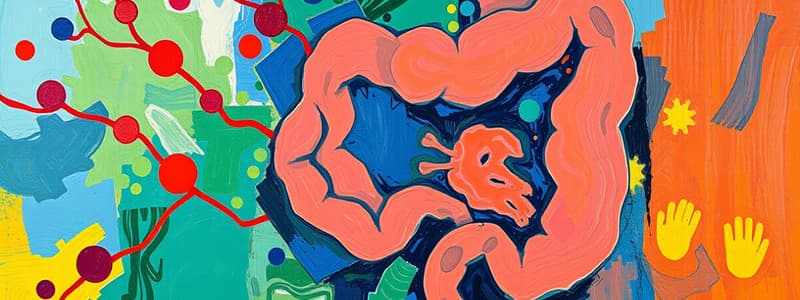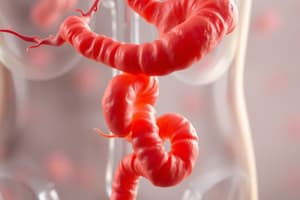Podcast
Questions and Answers
What role do tight junctions between intestinal epithelial cells (IECs) play in the small intestine's function?
What role do tight junctions between intestinal epithelial cells (IECs) play in the small intestine's function?
- Enhance the motility of the intestine
- Facilitate the secretion of digestive enzymes
- Prevent pathogens from entering circulation (correct)
- Increase nutrient absorption efficiency
Which factor does NOT contribute to the increased risk of peptic ulcers?
Which factor does NOT contribute to the increased risk of peptic ulcers?
- Smoking
- Increased gastric mucosal blood flow (correct)
- Use of NSAIDs
- H. pylori infection
What is a primary function of pancreatic fluid in the digestive process?
What is a primary function of pancreatic fluid in the digestive process?
- Breaking down fiber
- Regulating blood glucose levels
- Neutralizing acidic chyme (correct)
- Storing bile acids
Gastroparesis can lead to a reduction in which physiological function related to the stomach?
Gastroparesis can lead to a reduction in which physiological function related to the stomach?
What anatomical feature of the small intestine primarily increases its absorptive area?
What anatomical feature of the small intestine primarily increases its absorptive area?
How do histamine H2-blocking drugs assist in managing peptic ulcers?
How do histamine H2-blocking drugs assist in managing peptic ulcers?
Which condition is characterized by reduced stomach motility and may be caused by diabetes?
Which condition is characterized by reduced stomach motility and may be caused by diabetes?
Which of the following pancreatic functions prevents autodigestion of pancreatic tissues?
Which of the following pancreatic functions prevents autodigestion of pancreatic tissues?
Which hormone is primarily responsible for stimulating gastric acid secretion by parietal cells?
Which hormone is primarily responsible for stimulating gastric acid secretion by parietal cells?
What role does Cholecystokinin (CCK) play in digestion?
What role does Cholecystokinin (CCK) play in digestion?
How do opioid peptides affect gut motility?
How do opioid peptides affect gut motility?
Which component is responsible for immune protection within the small intestine?
Which component is responsible for immune protection within the small intestine?
What is the primary function of glucagon-like peptide 1 (GLP-1) in the digestive system?
What is the primary function of glucagon-like peptide 1 (GLP-1) in the digestive system?
What is the predominant characteristic of the colonic microbiota?
What is the predominant characteristic of the colonic microbiota?
What type of cells in the small intestine release serotonin, which can increase gastric motility?
What type of cells in the small intestine release serotonin, which can increase gastric motility?
Which immune components are primarily found in the colon to provide protection?
Which immune components are primarily found in the colon to provide protection?
Which of the following causes of acute pancreatitis can lead to repeated episodes that predispose an individual to chronic pancreatitis?
Which of the following causes of acute pancreatitis can lead to repeated episodes that predispose an individual to chronic pancreatitis?
What is the main function of the proximal small intestine in nutrient absorption?
What is the main function of the proximal small intestine in nutrient absorption?
Which mechanism of diarrhea is characterized by overwhelming secretions that surpass the absorption capacity of the gut?
Which mechanism of diarrhea is characterized by overwhelming secretions that surpass the absorption capacity of the gut?
In celiac disease, the ingestion of gluten leads to which critical event that impairs gut function?
In celiac disease, the ingestion of gluten leads to which critical event that impairs gut function?
Which end product of carbohydrate digestion is primarily absorbed in the proximal small intestine?
Which end product of carbohydrate digestion is primarily absorbed in the proximal small intestine?
What type of immune-based gut disorder results from the activation of resident immune protections that leads to impaired gut function?
What type of immune-based gut disorder results from the activation of resident immune protections that leads to impaired gut function?
Which of the following nutrients are traditionally absorbed in the duodenum of the small intestine?
Which of the following nutrients are traditionally absorbed in the duodenum of the small intestine?
Which type of diarrhea results from the osmotic imbalance caused by undigested molecules remaining in the gut?
Which type of diarrhea results from the osmotic imbalance caused by undigested molecules remaining in the gut?
Flashcards are hidden until you start studying
Study Notes
Hormonal Control of the GI Tract
- Endocrine cells in gut walls secrete hormones for medium- and long-distance signaling.
- G cells in the stomach antrum release gastrin, stimulating gastric acid secretion by parietal cells.
- Cholecystokinin (CCK) from the small intestine signals fat digestion products, inducing gall bladder contraction and bile secretion.
- Glucagon-like peptide 1 (GLP-1) secreted from the ileum decreases stomach motility and promotes insulin secretion from the pancreas.
GI Control by Peptides and Amines
- The enteric nervous system contains opioid peptides that reduce motility, aiding in diarrhea treatment.
- Opioid analgesics can lead to constipation due to their impact on gut motility.
- Enterochromaffin (EC) cells release histamine in the stomach and serotonin in the small intestine, stimulating gastric acid secretion and increasing gastric motility, respectively.
Immune Components of the Small Intestine
- The small intestine is equipped with significant immune protections against ingested pathogens.
- Peyer’s patches serve as central hubs for gut immune activity, monitoring intestinal contents.
Immune Components of the Colon
- The colon hosts the majority of gut microbiota, which aid digestion, immune function, and tolerance.
- It contains lymphocytes and macrophages that provide immune protection.
Clinical Aspects of Acute Pancreatitis
- Common causes include gallstones, alcohol consumption, and drug reactions.
- It can lead to critical illness, systemic inflammatory response syndrome, and multiorgan dysfunction.
- Repeated acute episodes can result in chronic pancreatitis.
Basic Principles of Gut Digestion and Absorption
- Nutrients are predominantly absorbed in the proximal small intestine (duodenum, jejunum).
- The vascularized gut supports nutrient uptake and circulation via the portal vein to the liver.
- End products of digestion include:
- Starches: glucose, galactose, fructose
- Proteins: amino acids
- Triglycerides: free fatty acids and glycerol
- Phospholipids: free fatty acids and lysophospholipids
- Cholesterol esters: cholesterol and free fatty acids
Common Mechanisms of Diarrhea
- Secretory: Triggered by bacterial exotoxins (e.g., cholera) causing secretion overload.
- Malabsorptive: Loss of gut surface area, seen in conditions like celiac disease.
- Osmotic: Occurs with lactase deficiency, where undigested lactose causes osmotic pull.
- Inflammatory: Associated with inflammatory bowel disease, leading to surface area loss and inflammation.
Immune-Based Gut Disorders: Celiac Disease
- Celiac disease arises from the immune response to gluten in sensitive individuals.
- Ingestion of gluten leads to the production of gliadin peptides, which become antigenic, causing pathological immune activation and impaired gut function.
Stomach Disorders: Peptic Ulcers
- Common sites for peptic ulcers are the duodenum and stomach.
- Risk factors include hyperacidity, smoking, bile reflux, and NSAID use.
- Helicobacter pylori infection increases the risk of ulcer recurrence and stomach cancer.
- Management of peptic ulcers involves reducing acid secretion through:
- Histamine H2-blockers
- Proton pump inhibitors
- Short-term antacids
Stomach Motility and Gastroparesis
- Normal stomach motility involves receptive relaxation to add food and strong contractions to mix and move chyme.
- Gastroparesis results from reduced motility due to altered neural modulation, often seen in diabetic autonomic neuropathy or after surgery.
Small Intestine Structure and Absorption
- Crypts and villi amplify the absorptive surface area of the small intestine.
- Intestinal epithelial cells possess microvilli, enhancing absorption.
- Tight junctions between cells prevent the entry of toxins and pathogens into circulation.
Importance of Pancreatic Enzymes in Digestion
- Pancreatic cells secrete enzyme inhibitors to prevent autodigestion.
- Pancreatic enzymes break down dietary proteins, carbohydrates, and lipids.
- Pancreatic fluid, rich in bicarbonate, neutralizes acidic chyme entering the duodenum from the stomach.
Studying That Suits You
Use AI to generate personalized quizzes and flashcards to suit your learning preferences.



